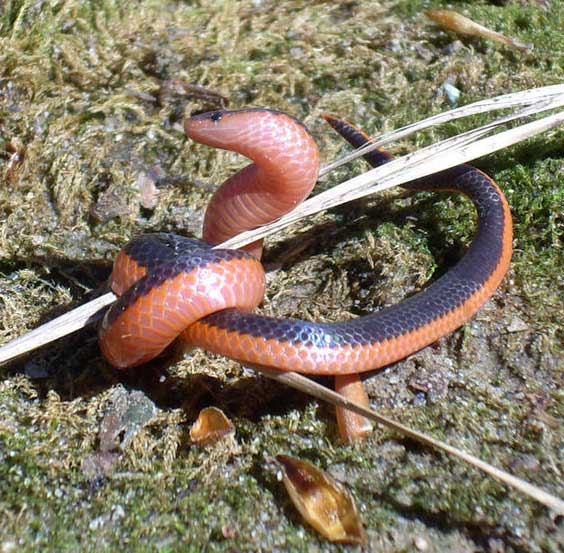
Carphophis vermis (*)
Superregnum: Eukaryota
Regnum: Animalia
Subregnum: Eumetazoa
Cladus: Bilateria
Cladus: Nephrozoa
Superphylum: Deuterostomia
Phylum: Chordata
Cladus: Craniata
Subphylum: Vertebrata
Infraphylum: Gnathostomata
Superclassis: Tetrapoda
Cladus: Reptiliomorpha
Cladus: Amniota
Classis: Reptilia
Cladus: Eureptilia
Cladus: Romeriida
Subclassis: Diapsida
Cladus: Sauria
Infraclassis: Lepidosauromorpha
Superordo: Lepidosauria
Ordo: Squamata
Subordo: Serpentes
Infraordo: Caenophidia
Superfamilia: Colubroidea
Familia: Dipsadidae
Subfamilia: Heterodontinae
Genus: Carphophis
Species: Carphophis vermis
Name
Carphophis vermis (Kennicott, 1859)
Holotype: USNM 2180.
Type locality: “Missouri”.
Combinations
Celuta vermis Kennicott, 1859: 99 [original combination]
Carphophiops vermis — Cope, 1875: 34 [subsequent combination]
Carphophis amoena var. vermis — Garman, 1884: 101 [subsequent combination]
Carphophis vermis — Clark, 1968: 110 [subsequent combination]
References
Primary references
Kennicott, R. 1859. Notes on Coluber calligaster of Say, and a description of a new species of Serpents in the collection of the north Western University of Evanston, Ill. Proceedings of the Academy of Natural Sciences of Philadelphia 11: 98–100. BHL Reference page.
Cope, E.D. 1875. Check-list of North American Batrachia and Reptilia, with a systematic list of the higher groups, and an essay on Geographic distribution: Serpentes: Based on the specimens in the U.S. National Museum. Government Printing Office: Washington. 104 pp. BHL
Garman, S. [1883] 1884. The reptiles and batrachians of North America. Part I. Ophidians. Memoirs of the Museum of Comparative Zoology 8: 1–185. BHL
Clark, Jr., D.R. 1968. A Proposal of Specific Status for the Western Worm Snake, Carphophis amoenus vermis (Kennicott). Herpetologica 24(2): 104–112. JSTOR
Links
Uetz, P. & Hallermann, J. 2021. Carphophis vermis. The Reptile Database. Accessed on 4 May 2018.
Hammerson, G.A. 2007. IUCN: Carphophis vermis (Least Concern). The IUCN Red List of Threatened Species 2007: e.T63739A12712214. DOI: 10.2305/IUCN.UK.2007.RLTS.T63739A12712214.en
Vernacular names
English: Western Worm Snake
Carphophis vermis (common name western worm snake[5]) is a species of small, nonvenomous colubrid snake native to the United States.
Etymology
The specific name, vermis, is Latin for "worm".[6]
Physical description
Western worm snakes have a dark, black or purplish dorsal coloration, with a lighter, pink or reddish underside.[7]
Adults are usually from 19–28 cm (7.5–11 in) in total length; however, the maximum recorded total length is 37.5 cm (14.8 in).[8]
Geographic range
Western worm snakes are found in the United States in southern Iowa, southeastern Nebraska, eastern Kansas, western Illinois, Missouri, Louisiana, eastern Oklahoma, and northeastern Texas with isolated records from southwestern Wisconsin, southeastern Arkansas and middle Tennessee.[4]
Behavior
Worm snakes are fossorial, and spend the vast majority of time buried in loose, rocky soil, or under damp forest leaf litter. They are abundant within their range, but rarely seen due to their secretive nature.[9]
Reproduction
Little is known about their mating habits, but breeding likely occurs in the early spring. Eggs are laid in the early summer. Clutch size is normally 1-8 eggs, and hatching takes place in August or September. Hatchlings range in size from 3 to 4 inches (7.6 to 10.2 cm) in total length.
Diet
The worm snake's diet consists almost entirely of earthworms,[9] but it will also consume soft-bodied insects.
Defense
If harassed, it will often release foul smelling musk from its cloaca. If handled, it may press its tail tip into the captor's hand as a defense mechanism.
References
Stejneger, L., and T. Barbour. 1917. A Check List of North American Amphibians and Reptiles. Harvard University Press. Cambridge, Massachusetts. 125 pp. (Carphophis vermis, p. 74.)
Conant, R., and W. Bridges. 1939. What Snake Is That? A Field Guide to the Snakes of the United States East of the Rocky Mountains. (with 108 drawings by E. Malnate) D. Appleton-Century. New York and London. Frontispiece map + viii + 163 pp. + Plates A-C, 1-32. (Carphophis amoena vermis, p. 32 + Plate 2, Figure 5.)
Wright, A.H., and A.A. Wright. 1957. Handbook of Snakes of the United States and Canada. Comstock. Ithaca and London. 1,105 pp. (in two volumes) (Carphophis amoenus vermis, pp. 110-112, Figure 35 + Map 12 on p. 105.)
The Reptile Database. www.reptile-database.org.
http://www.zo.utexas.edu/research/txherps/snakes/carphophis.vermis.html
Mish, F.C., Editor in Chief. 2004. Merriam-Webster's Collegiate® Dictionary, Eleventh Edition. Merriam Webster. Springfield Massachusetts. 40a + 1,623 pp. ISBN 0-87779-809-5. ("worm", p. 1444.)
Smith, H.M., and E.D. Brodie, Jr. Reptiles of North America: A Guide to Field Identification. Golden Press. New York. 240 pp. ISBN 0-307-13666-3. (Carphophis amoenus vermis, pp. 162-163.)
Conant, R. 1975. A Field Guide to Reptiles and Amphibians of Eastern and Central North America, Second Edition. Houghton Mifflin. Boston. xviii + 429 pp. ISBN 0-395-19979-4 (hardcover), ISBN 0-395-19977-8 (paperback). (Carphophis amoenus vermis, p. 175 + Plate 25 + Map 131.)
Schmidt, K.P., and D.D. Davis. 1941. Field Book of Snakes of the United States and Canada. G.P. Putnam's Sons. New York. 365 pp. (Carphophis amoena vermis, pp. 102-104, Figure 20.)
Further reading
Behler, J.L., and F.W. King. 1979. The Audubon Society Field Guide to North American Reptiles and Amphibians. Knopf. New York. 743 pp. ISBN 0-394-50824-6. (Carphophis amoenus vermis, p. 592 + Plate 493.)
Kennicott, R. 1859. Notes on Coluber calligaster of Say, and a description of new species of Serpents in the collection of the North Western University of Evanston, Ill[inois]. Proc. Acad. Nat. Sci. Philadelphia [11]: 98–100. (Celuta vermis, pp. 99–100.)
Retrieved from "http://en.wikipedia.org/"
All text is available under the terms of the GNU Free Documentation License

